§1. ORIGINALITY OF MACAO ST. PAUL'S ARTISTIC WORK
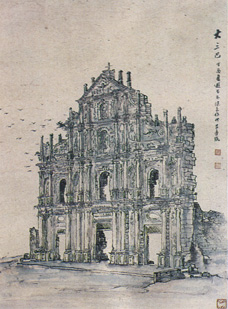 PREVIOUS PAGE:
Ruins of St. Paul.
LU SHOUKUN 呂壽琨 [LUI SHOU KWAN] (°1919-†1975).
1957. Watercolour on paper. 74.0 cm x 53.5 cm.
Luís de Camões Museum/Leal Senado, Macao.
PREVIOUS PAGE:
Ruins of St. Paul.
LU SHOUKUN 呂壽琨 [LUI SHOU KWAN] (°1919-†1975).
1957. Watercolour on paper. 74.0 cm x 53.5 cm.
Luís de Camões Museum/Leal Senado, Macao.
In terms of the artistic achievement of missionaries of the Society of Jesus in the Orient and mainly in China, the study of the artistic work of the Society in Macao is of great importance because the Church of the Holy Mother of God's College (or of Our Blessed Lady of the Assumption, or St. Paul's) and its facade were build between 1601 and 1640, which besides being the most important period of Christian history in China, was also a time of great construction for the Society of Jesus.
Working for the Royal Portuguese Ecclesiastical Patronage, the Society of Jesus based its operations in Macao from 1565, with a view to gaining entrance to China. While the Church of the Holy Mother of God's College was under construction, in the latter years of the Ming Dynasty, the Society of Jesus arrived in Beijing, while Portugal was under Spanish rule, which lasted until 1640. The City of Macao witnessed the race to control the sea trade in the Far East with contenders like Portugal, Spain, England and the Netherlands.
The Holy Mother of God's College, was at that time an important missionary centre and a Cultural meeting point, as it witnessed an extraordinary and unique experience in terms of contact and exchange between European and Chinese Civilisations.
The Jesuit foundation of Macao is responsible for a magnificent monument, the St. Paul's facade, which is considered to be both a masterpiece and the summit of Christian art in the Far East. Various circumstances are connected with and exert some sort of influence in terms of its 'plastic' expression.
The uniqueness of the façade of the Holy Mother of God's College is worth a detailed study which should not be limited to the formal value in architectural setting. Its existing grand flight of steps deserves to be included in the study, not only in terms of its religious art but also as a main urban feature of a growing City.
In addition to the reasons explained below it seems very important to carry out a thorough investigation of the title theme (provisional); I hope that shortly I will be able to present some more interesting documents concerning the study of St. Paul's Church within the art of the Society of Jesus, in China. 1
Carrying out a thorough study of the art of the Society of Jesus in Macao is even more important if we look at the facade of the old Jesuit College Church as revealing unquestionable features and at the same time representing a major connotative element of the adaptation programme designed by the Society of Jesus with a view to spreading the word of Christ in China. In these circumstances, the relationship between architecture and rhetoric depicted in the façade suggested a new religious art iconography after the Trent Council (1545-1563). This is further enhanced in the same work by means of resorting to construction and decoration solutions based on Oriental features.
Furthermore it should be stressed that the buildings erected by Jesuits in China which combine Eastern and Western Art are not referred to in any books or manuals of Art History of the seventeenth and eighteenth centuries.
The Yuanmingyuan raised the very same subject in a very pertinent way as regards European Palaces in the Chinese Court which were built in accordance with plans mainly designed by Jesuit Giuseppe Castiglione (°1688-†1766) because they are an aesthetic "compromise" between some Chinese structural and constructive rules and a "Western style architecture designed and decorated by artist-missionaries". In view of the above, Daniel Rabreau and Marie-Raphael Paupe were curious to know about the European Palaces in Beijing and questioned whether they featured an "original style or combined tastes".
In their conclusion, 2 these authors stated that the programme implemented by the Qianlong Emperor (in 1747) and left to the missionaries' own creativeness, thus far from the creative emulation of European Courts and Cities, shows how "inventive" and original this work was in artistic terms.
Previously, Delatour stated that architecture such as it was implemented in Europe, had no means to classify what missionaries in China called "European style Architecture" and therefore proposed to call it "Italian-Gothic-Chinese" architecture. However, the majority of experts considered that such works were a pitiful compromise between European taste and Chinese aesthetics.
As regards the Church of St. Paul, which indeed is not referred to in any history of traditional art, studies and researches carried out or yet to be carried out should give us a better understanding of the phenomena behind these rare artistic objects. New studies should go beyond the scope of comparative architecture (which is undoubtedly of great interest) while searching for new methods of analysing the history of art.
The vast number of documents published throughout this century, thanks to Charles Boxer, Jose Maria Braga, António da Silva Rego, Manuel Teixeira, Videira Pires and Pasquale D'Elia, among others, gave room to some historical research studies and works on this Jesuit temple in Macao.
Among the documents referred to above are: The Church of St. Paul in Macao, by Monsignor Manuel Teixeira3 and the article An Architectural Survey of the Jesuit Seminary Church of St. Paul's, 4 Macao, by Professor Hugo Brunt. Even though these are considered pioneering works given their documental and graphic research as well as the clues provided, they fail to give complete answers to the abounding questions about this work of art; they refer neither to the true authors of this work nor to other iconography-related issues.
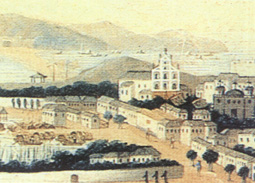 Landscape view of Macao, including the Church of St. Paul before the fire of 1835. Unknown artist. Macanese work of the late eighteenth century.
Oil on canvas-detail.
Hong Kong Museum of Art, Hong Kong.
Landscape view of Macao, including the Church of St. Paul before the fire of 1835. Unknown artist. Macanese work of the late eighteenth century.
Oil on canvas-detail.
Hong Kong Museum of Art, Hong Kong.
§2. THE JESUIT FOUNDATION OF MACAO AND THE ENTRY OF MISSIONARIES INTO CHINA
Apparently, the peninsula of Macao was given to the Portuguese Crown to reward approximately five hundred Portuguese who helped the Chinese to fight pirates abounding in the South China seas. 5 In addition, in 1553 or 1554, Leonel de Sousa agreed to establish a settlement in Guang Hai, Guangdong Province, with the harbour's Administrator.
In 1542 or 1543, some renegade Portuguese had discovered Japan by chance and so Macao benefited a great deal from this discovery. After 1557, the Portuguese took over the port of Macao, creating a safe commercial base from where they could control which consisted in the Goa-Malacca-Macao-Guangzhou-Nagasaki route. After this, the Portuguese were allowed to attend the Guangzhou fair and even enjoyed fees lower than usual, while war ships were exempted from fees. The first decades of this new colony therefore enjoyed prosperous commercial relations thanks to the bi-annual trade with the neighbouring City of Guangzhou, where spices were exchanged for Chinese silk. Every year, the Nao-do-Trato loaded with silk, left Macao for Japan where goods were sold at very high profits, payments being made in silver ingots.
Some decades later (ca 1630), there were in Macao around eight-hundred-and-five Portuguese with their children, "stronger and braver than Oriental people".6The Portuguese were surrounded by slaves, some Chinese and their jurubassas (ie : translators). The small enclave' s prosperity relied mainly on the annual trip to Japan. However, ships sailing from Macao also had other destinations such as Manila, Solor, Korea and, of course, Goa.
With this settlement in the South of China, Portugal became a pioneer in the relations between Europe and Asia in view of the opening of China to foreign trade toward the end of the Ming Dynasty.
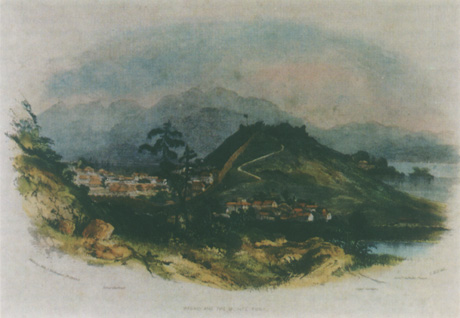 Macao and the Monte Fort. A view showing Macao's ramparts.
Unknown artist[C. H. S.], ca 1840. Print with colour wash.
Macao and the Monte Fort. A view showing Macao's ramparts.
Unknown artist[C. H. S.], ca 1840. Print with colour wash.
Together with the increasing commercial power, secular Clergy and religious Orders arrived in this City with a view to providing religious help to Christian people, both European and Asian. At the same time, on the other hand, in order to convert natives to Christianity, religious Orders had access to trading posts and Cities in the Orient where Portuguese or Spanish traded and settled.
This movement brought the Jesuits, Franciscans, Dominicans, Augustinians and Clarists to Macao. From the beginning, and despite the very poor conditions they had to face, these missionaries had one goal in mind and that was to conquer China in religious terms in addition to giving religious succour to the port's population.
With the Pope's approval, the Society of Jesus (founded in 1540) was called to Portugal by King Dom João III who assigned to them the mission of spreading Christianity in India. Through this the Society of Jesus was to play a major role in the apostolate of China in religious, scientific and cultural terms.
The Society's members reached Macao in the early days of its foundation, at first on their way to Japan and then returning from that country. Nevertheless, their major concern after 1552 (the year in which Fr. Francisco Xavier died) was to spread Christianity in China.
On the 29th of June 1563, Gil de Gois'Royal Embassy arrived in Macao. With the Embassy came Frs. Francisco Perez, Manuel Teixeira and Br. André Pinto who were "to do what had been planned to be done when Fr. Francisco [Xavier] was first sent there",7 according to Alessandro Valignano, the Visitor to the Orient's missions.
These three members of the Society of Jesus were part of an Embassy directed by the King of Portugal and prepared by the Viceroy of India, Francisco Coutinho. However, it was unsuccessful because the Captain of Malacca, Francisco de Eça, apparently did not grant it the proper means. Soon after this diplomatic mission failed its goals, these three Jesuits received new guidelines. In 1565, the Provincial Fr. of India, António Quadros, directed them to have their own House and leave the rooms they occupied at Pero Quintero's.
The first "hospice" or the Society of Jesus's own house in Macao was then established. This was very advantageous because those missionaries belonging to the Japan mission could stay there while waiting to leave for Goa or Japan, whilst on the other hand the Society could organise in its own premises the future settlement of its missionaries on the Chinese continent.
The first Jesuit Residence in Macao was no more than "some one-storey houses" with wooden partitions featuring a straw-made chapel. Usually these were occupied by two Frs. and a Br. who were assisted by those priests on their way to Japan. For a short while its first superior was Fr. Francisco Perez. 8
After this the Jesuit mission in Macao developed swiftly. As it helped in the bringing up of the Portuguese traders' children, in 1572 a small school was built (primarum litterarum scholam) next to the Society of Jesus Residence. Later on, in order to respond to the needs of the Japan mission and to train priests for this region, in 1592 they opened a Seminary- cum -University. 9
A fire destroyed the first chapel but this was the only place of worship to be destroyed by fire. Other Churches in Macao, for example, St. Lawrence and St. Anthony were also burnt down.
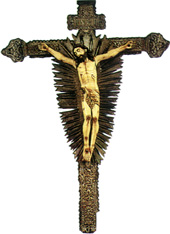 Crucifix.
Sino-Portuguese work from the seventeenth century.
Wood, silver and ivory. 82.0 cm x 58.0 cm.
Church of St. Lawrence, Macao
Crucifix.
Sino-Portuguese work from the seventeenth century.
Wood, silver and ivory. 82.0 cm x 58.0 cm.
Church of St. Lawrence, Macao
However, the major goal of placing missionaries in China was yet to be achieved even though such action was tested more directly by means of biannual trips to Guangzhou. In 1575 Fr. Cristóvão da Costa stayed two months in Guangzhou but failed to be given the necessary permit because the Chinese thought that foreigners living in their country would jeopardise their interests.
A new approach to placing Jesuits in China was determined by a courageous man, Alessandro Valignano (° 1539-†1606), Visitor to India.
In August 1578 Valignano arrived in Macao after staying in India from 1576 to 1577. He soon realised that the Chinese doors would remain closed unless missionaries learned the "Chinese writing". He then asked Goa to send him a priest whose sole task was to learn Chinese. In response, the India's Provincial Fr. sent Miguel Ruggieri, who arrived in Macao in 1579, but Alessandro Valignano had already left for Japan; the latter having left a written message to the former, directing him to start learning Chinese.
Despite his initial frustration, Fr. Ruggieri commited himself to this new task for he knew that the whole mission depended upon it.
To enable this missionary to work, a catechumen House was built. It was the São Martinho de Tours catechumenate and featured a small chapel where neophytes were given instruction. A fellow of his described Ruggieri's experience of living among the Chinese as follows:"Mail P. Ruggiero con la prudenza e piacevolezza del suo tratare ad ogni cosa provide; e di qua prese occasione di ragionar con molti Chini con lor gusto; e particolarmente a Prefetto delle marine, che Haitao chiamano; soto al quale tutti li mercanti forestieri, e le mercantie, che passano al Cantone. [...] Non poco operó questa stretta amicitia co' Magistrati a persuader loro l'eccelenza della Religione nostra, poiché dopò non furono pochi quelli I quali li portavano le vetovaglie a Macao, che riciverono il Battesimo. Ond'avvenne, che essendo cresciuto il numero de' Cathecumeni, com l'elemosina de' Portughesi, fù el vicino colle, appresso alla nostra Chiesa fabricata una casa ed una Chiesiola detta l'Oratorio di S. Martino. Ivi si amaestravano quelli del paese, e nella parte di basso s'attendeva alla salute de'Portughesi. Ivi anco più liberamente s'attendeva allo studio de'libri Chinesi. "10
Valignano came to realise how difficult this mission was despite the progress it had achieved. Therefore and in view of the fact that his "workers" were fully occupied, he decided to send Fr. Matteo Ricci to follow Ruggieri in his mission. Ricci arrived in Macao on the 7th of August 1582, and stayed at the catechumen house. While Ricci studied Chinese, Frs. Michele Ruggieri and Francesco Pasio went to Zhaoqing, and managed an appointment with the Viceroy of Guangdong toward the end of December. However they failed to be allowed to settle in Chinese territory. The plan failed because a new Viceroy of Guangdong was appointed in the meantime and so this major step of the St. Ignatius Order had been yet again postponed.
Missionaries settled in China some time later and on the 10th of September 1583 where they were granted a piece of land in Zhaoqing. Here they founded the historical Residence11 where Matteo Ricci, Michele Ruggieri, a Brother and an interpreter lived.

Jesuit Saint (probably either St. Ignatius of Loyola or St. Francis of Borgia).
Portuguese work with Oriental influence from the seventeenth century.
Wood with traces of tint, polychromy and gilding. 173.0 cm x 69.0 cm.
Maritime Museum, Lisbon.
The assistance given by the Jesuit Order of Macao went well beyond the missions in China and Japan. This Residence underwent successive reconstruction and expansion works in 1572, 1575 and 1578. In 1594 major works were also carried out following Valignano's orders. His purpose was to turn the Residence into a University College and Head of the Japan Province.
In 1594, a Superior independent from that of the Resident was appointed to the College. However, three years later both institutions were managed by one Superior only. That year Valignano appointed Ricci as the first Superior of the China mission.
§3. THE MACAO POPULATION- NEW CHURCH PATRONAGE THE COLLEGE OF THE HOLY MOTHER OF GOD - AN ARTS CENTRE
At the College of the Holy Mother of God, the construction of a temple started in 1601 and was inaugurated at Christmas, in 1603. Its façade, like the existing one, was added later in 1640 or 1644. It was necessary to build a new temple because a fire had burned down the original Church, not to mention a portion of the College.
The Macao population helped in the construction of the temple and this fact is shown on a stone located at the foot of the façade and described in documents kept in Rome and Lisbon. 12 The full list of the major benefactors who helped in the construction of both the Church and College has been printed in Manuel Teixeira's works Macao and its Diocese and The Church of St. Paul in Macau.
The 1601 annual letter written by the Macao College Principal to the General of the Society of Jesus, Claudio Aquaviva, refers to both the damage caused to the College and Church and the surprising help given by the population in putting out the fire, as well as the solidarity arising from this tragedy.
Upon construction, the first mass was held on Christmas Eve and Fr. Visitor Alessandro Valignano officiated. He also had the consecrated Host moved from the temporary chapel. This solemn ceremony featured a long procession through the main streets of the growing settlement consisting of approximately sixty religious persons of the Society; Fathers, Brothers, and five biers bearing the College's relics and images. In addition to being the opening of a Society of Jesus temple, it was also a celebration held by the people who at last had "their" Church finally completed.
Its construction was funded partially by traders who had promised after the 1601 fire, to donate a half percent of the shipment they had in Japan in that specific year. They kept their promises.
Work was not over with the 1603 opening. There was more work to be done in the interior, on the façade and new side entrances. Altars and chapels were decorated at a later date.
In a letter of 1627, referring to its interior, Fr. Rodrigues Girão commented: "I wish your Reverence were here to see how wonderfully decorated the church is and will be when all works are fully completed. It will be the most beautiful church in the Orient."
But references to the great beauty of this temple are not limited to this letter. Some years later Peter Mundy, another traveller, commented on the uniqueness of the ceiling decoration carried out by Chinese, which he considered as "the most wonderful"13 he had ever seen.
Others considered it a sumptuous and extremely beautiful temple, the beauty of which was unparalleled, even when taking into consideration the Roman contemporary Churches. 14
There was of course one exception, and that was the Basilica of St. Peter. However, the reason for the above comments were based on the surprise by which people were struck when facing this Church in such a faraway place.
The wonderful vision of its interior was topped by "very rare"15 paintings that drew the observer's eye. Some of these paintings depicting religious themes may have been painted by Japanese and Chinese who had just learned the Western oil painting techniques and the chiaroscuro technique which was also unknown to the Chinese prior to the missionaries' arrival.
Giovanni Nicolao, an Italian Jesuit painter, helped to found a painting school in Macao. Later, a similar school opened in Arima, Japan, and became renowned for its brilliant followers. 16
Some of these Japanese painters who later took shelter in Macao, after 1614, practised their art while decorating the Church of St. Paul in addition to painting for the China mission, thus meeting many requests. These were intended to be given as gifts to judges or to decorate new chapels in Houses owned by the Society of Jesus or even to be offered to new Christians.
One of the most famous painters was Jacob Niva who learned the trade with Giovanni Nicolao. He went to Macao in 1601 and his final destination was the China mission. The painting he made depicting Our Lady with the Child in her arms was offered to the Emperor. However, Jacob Niva was also working in the Church of the Holy Mother of God Seminary- cum -College when, in 1606, Matteo Ricci, Superior of the Beijing mission, sent him to Macao "per pingere alcune cose di quella chiesa nuova. "17 He made a large painting called The Martyrdom of the Eleven Thousand Virgins for the Virgins' Chapel located next to the Epistle, and another one entitled The Assumption of Our Blessed Lady, surely for the main chapel's retable, since the Church was dedicated to Our Blessed Lady of the Assumption.
§4. ART AND ADAPTATION - A STRATEGY OR A CONSEQUENCE OF A NEW METHOD?
We can still admire the majestic façade of the old Church of St. Paul, as it is the only thing that withstood the fire that broke out by accident in the old College's kitchen in 1835, some decades after the Society of Jesus had been expelled from Macao the troops of the Prince Regent's Battalion were accommodated at the old College for at that time, following a decree issued by the Marquis of Pombal on behalf of King Dom José I. The fire spared the facade and the magnificent steps, which gives us clues as to how well integrated in the City this monument was.
The façade was designed and built with a sense of greatness. Its architectural elements, like its columns with bases which feature sculptural dimensions due to the light and shade combination which can be seen at the entrance level. The prominent columns were used as a decoration feature only.
The new iconographic elements incorporated in this temple are of major interest in this religious art monument. This is explained by the incorporation of Chinese characters and other elements which were unfamiliar to the European religious architecture of that time. These elements consisted of representations of the Devil or Death, not to mention the set of symbols unfamiliar to the religious art iconography after the Council of Trent.
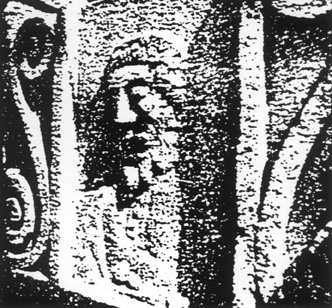
Medallion probably representing the portrait of Fr. Carlo Spinola [or possibly, Alessandro Valignano]. St. Paul's façade ocidental topmost return.
In: Ruínas de S. Paulo(As): St. Paul's Ruins-Um Monumento para o Futuro: A Monument towards the Future, Lisboa-Macau, Sept.-Dec. 1994, p.73, fig. 3.
It should be emphasised that those innovative or unknown features comprised in this work of art are a result of a new missionary method (ie : the "Adaptation"), an innovative apostolate, as opposed to that previously used in Africa or America (ie : the "tabula rasa"). This was a new method tried by Francisco Xavier, designed by Alessandro Valignano and implemented successfully by Matteo Ricci and Michele Ruggieri. However it should be stressed that this "approaching" process counted on the efforts of twenty-seven Jesuits, members of other religious Orders and secular Clergy who had entered China before Ricci with the purpose of founding missionary settlements there, as reported by Fr. Videira Pires in one of his books. 18
Nevertheless, missionaries of the Society of Jesus were able to enter and settle in China thanks to the door opened by the courageous Matteo Ricci. In a letter dated 1595 Ricci explained why he was so famous. The first reason was the fact that he, as a foreigner and coming from afar, could speak and write Chinese. The second reason was his outstanding memory. He knew the works of Confucius by heart. His knowledge of Mathematics was great and the objects he carried with him caused admiration (like clocks, glass prisms, and so forth). Religion came last.
To profit the most from their condition, quite naturally, the Jesuits tried to change the order in which Chinese were interested in them. In accordance with Jacques Gernet's cunning statement, they used European science to achieve religious progress in this "seduction enterprise".19
As to the Church of St. Paul, a key work of art in the Art of the Society of Jesus in China, it should be studied bearing in mind both the aforementioned factors and in the light of prescriptions or rules of the Society of Jesus on buildings which internally was called "il modo nostro". In addition, these factors should be compared with the Western and Eastern contemporary artistic practices which are also present in this work.
To understand the Art of the Society of Jesus in Macao and China as a result of a strategy and consequence of assimilation, an assessment of the existing inter-relations together with a new missionary methodology (which was undoubtedly more important in the early years) should be carried out.
NOTES
1The study in hand is carried out under the supervision of Prof. Bruno Neveu, "Directeur d'Études", at Section IV (Sciences Historiques et Philologiques) of the École Pratique des Hautes Études, Sorbonne, Paris, and has been developed within the regular work of conferences called IMAGE CULTURELLE DE L'EUROPE--L'Europe et l' Orient, together with Prof. Jean Aubin.
2RABREAU, Daniel-PAUPE, Marie-Raphaël, Le Yuan Ming Yuan, Jeux d'eaux et Palais Européens du XVIIIe siècle à la Cour de Chine, Paris, Recherches sur les Civilisations, 1987.
3TEIXEIRA, Manuel, The church of St. Paul in Macau, in: "Studia", Lisboa, (41-42) Jan.-Dec., 1979, pp. 51-111.
4BRUNT, M. Hugo, An Architectural survey of the jesuitic seminary of the church of St. Paul's Macao, in: "Journal of Oriental Studies", Hong Kong, 1 (2) July, 1954, pp. 327-344.
5REGO, A. da Silva, A presença de Portugal em Macau, Lisboa, Agência Geral das Colónias, 1946, p.25.
6BOXER, Charles Ralph, Seventeenth century Macau in contemporary documents and illustrations, Hong Kong, Heineman, 1984, p. 15.
7TEIXEIRA, Manuel, Macau e a sua Diocese, Macau, Tipografia do Orfanato Salesiano, 1940-1979, pp. 142-170; PIRES, Benjamin Videira, O IV Centenário dos jesuítas em Macau (1564-1964), Macau, [n. n.], 1964.
8PIRES, Benjamin Videira, op. cit., p. 33, n. 77.
9SANTOS, Domingos M. Gomes dos, Macau/primeira universidade ocidental do Extremo-Oriente, offprint ANAIS of "Academia Portuguesa de História", Lisboa, 17(2) 1968, pp. 219-231.
10TRIGAULT, Nicolas, Entrata nella China de'Padri della Compagnia del Gesù: Tolta dai Commentari del P. Matteo Ricci di detta Compagnia, Roma, Edizione Paoline, 1983, chap. 2, p.156.
11CABRAL, Francisco - RICCI, Matteo - RUGGIERI, Miguel - PASSIO, Francesco, Avvisi della Cina dell'ottantatre et dell'ottantaquattro, Ed. RINESTRA, M. Howard, "Jesuit Letters from China, 1583-84", Minneapolis, University of Minesota Press, 1986, p.22.
12BA: JA, 49-IV-66, fols. 85-87, "Titolo dos bemfeitores principais deste Collo. de Macao".
See: PIRES, Benjamin Videira, Macau e os Jesuítas - Os benfeitores do Colégio e a Igreja da Madre de Deus, "Religião e Pátria", Macau, (26-40) 10 Jul.-23 Oct. 1955; TEIXEIRA, (1940-1979), op. cit., vol. 3, p.189 ff.
13TEIXEIRA, (1979), op. cit., p.71; BOXER, Charles Ralph, op. cit., p.41.
14RHODES, Alexandre, Sommaire des Divers Voyages et Missions Apostoliques, du P. [...], à la Chine, & autres Royaumes de l'Orient, avec son retour de la Chine à Paris. Depuis l'Année 1618 jusques à l'année 1653, Paris, Florentin Lambert, 1680, pp. 20-30.
15Ibidem., p.23
16TEIXEIRA, (1979), op. cit., p. 66ff.
17ARSI: Jap.-Sin., 14, fol. 231 vo.
18PIRES, (1964), op. cit., p.7, n.7.
19GERNAT, Jacques, Chine et Christianisme. La première confrontation, Paris, Gallimard,1991, p. 25ff.
* Researcher on Christian Missions and Religious Art. BA in the History of Art, Lisbon; Ph. D in the History of Art from the Sorbonne, Paris. Thesis dissertation: The Church of Our Blessed Lady of the Assumption, in Macau and the Art of the Society of Jesus in China: Art and Adaptation.
start p. 27
end p.